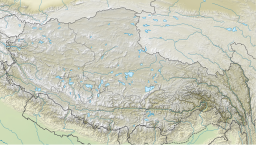| Siling Lake / Selincuo | |
|---|---|
 | |
| Location | Nagqu Prefecture, Tibet, China |
| Coordinates | 31°50′N89°00′E / 31.833°N 89.000°E |
| Basin countries | China |
| Surface area | 1,865 km2 (720 sq mi) |
| Surface elevation | 4,530 metres (14,860 ft) |
| Official name | Tibet Selincuo Wetlands |
| Designated | 8 January 2018 |
| Reference no. | 2352 [1] |
Siling Lake (Tibetan : སེར་གླིང་མཚོ, Wylie : ser gling mtsho, ZYPY : Sêling Co; Chinese :色林错; pinyin :Sèlín cuò), (also known as Qilin or Selincuo) is a salt lake in the Tibet Autonomous Region, China to the north of Xainza. Doijiang is located near the lake. Administratively it belongs to Xainza County and Baingoin County of the Nagqu.
Contents
Bangecuo is another nearby salt lake [2] located east of Siling Lake, [3] around four miles away.


